Post-war service and combat use of 105 mm howitzers manufactured in Nazi Germany
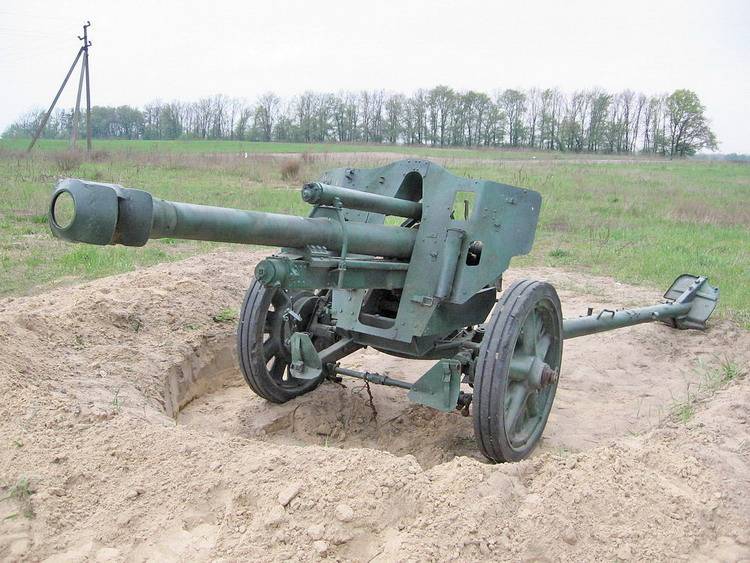
105-mm howitzers 10,5 cm le.FH18 were widely used in the armed forces of the Third Reich and, due to their good service, operational and combat characteristics and relatively low cost, are among the most successful artillery systems of the Second World War. Le.FH18 guns of various modifications were used by German troops from the first to the last days of the war.
In the post-war period, le.FH18 howitzers continued to serve in a number of countries and were in definite demand on the global arms market. These guns were the basis for the creation of their own howitzers in Yugoslavia and Czechoslovakia. The latest cases of combat use of 105-mm howitzers with German roots were recorded relatively recently.
History of creation, mass production and characteristics of the light 105-mm howitzer 10,5 cm le.FH18
During the First World War, the German army had light field howitzers 10,5 cm le.FH16 (German: 10,5 cm leichte Feldhaubitze 16–10,5 cm light field howitzer model 1916). For its time it was a very good artillery system. With a howitzer mass in combat position of 1 kg, its maximum firing range was 525 m, and the combat rate of fire was up to 9 rounds/min. In 200, the Imperial German Army had just over 5 le.FH1918 howitzers.
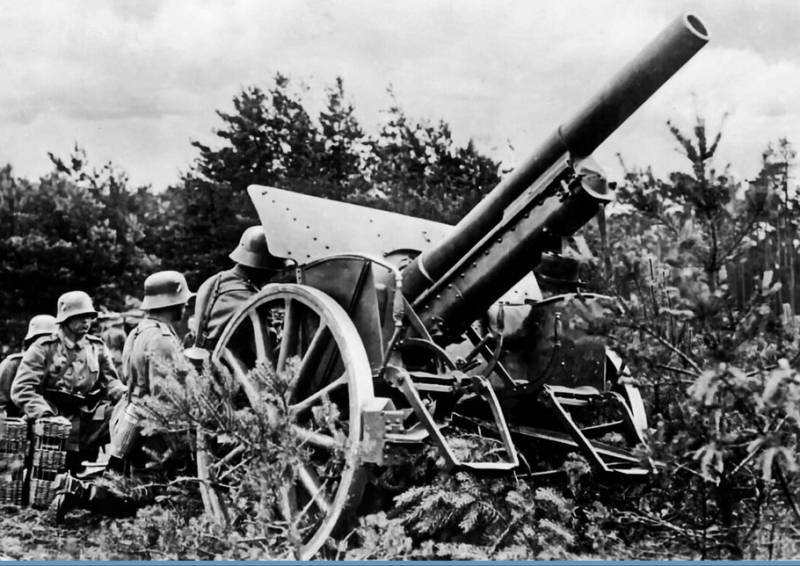
Howitzer 10,5 cm le.FH16 with crew at a firing position, photograph taken in the early 1930s
As a temporary measure until the adoption of the new 105 mm howitzer, an improved version of the 1933 cm le.FH1937 nA (German: neuer Art - new model) was produced from 10,5 to 16. In total, the customer accepted 980 of these guns.
By the beginning of World War II, the original 10,5 cm le.FH16 and improved 10,5 cm le.FH16 nA howitzers were considered obsolete. Nevertheless, they were used in secondary sectors of the front and were placed in the fortifications of the Atlantic Wall.
Due to the need for a more advanced weapon of this caliber, the Rheinmetall-Borsig AG concern created the 105-mm howitzer 10,5 cm le.FH18, which was put into service in 1935. Like many other German artillery systems created in the 1930s, this howitzer was called “mod. 18", which made it possible to bypass the formal restrictions imposed by the Treaty of Versailles.
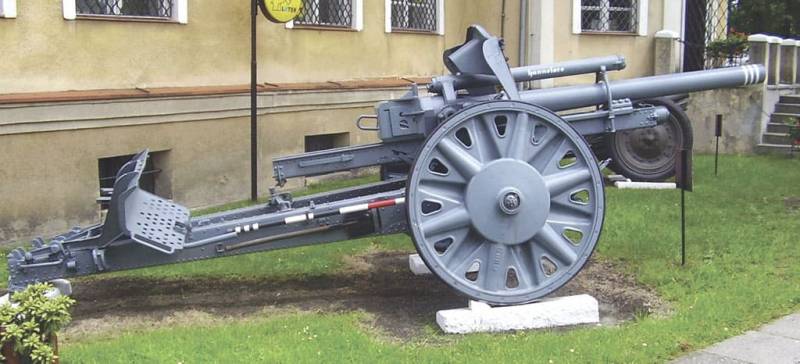
Field howitzer 10,5 cm le.FH18 on display at the museum
The mass production of le.FH18 howitzers was facilitated by their relatively low production costs. The 105-mm howitzer was cheaper and required less labor to manufacture than other German serial artillery guns used at the regimental and divisional levels.
In terms of economic indicators, the le.FH18 howitzer was significantly superior to even a 75-mm light infantry gun intended for use at the battalion and regimental level. Thus, in 1939, the German Ministry of Armaments paid the manufacturer 10,5 Reichsmarks for the 18 cm le.FH16 howitzer, and 400 Reichsmarks for the 7,5 cm le.FK18 infantry gun.
Compared to the 10,5 cm le.FH16, the 10,5 cm le.FH18 howitzer had a number of significant advantages. With a barrel length of 2 mm (625 klb.), the maximum firing range was 25 m.

A fundamentally new difference between the le.FH18 and the le.FH16 was the carriage with sliding frames and large folding coulters, as well as the carriage suspension. The combat axis was equipped with springs, which made it possible to transport the howitzers using mechanical means of traction. Thanks to three points of support, the carriage with sliding frames became much more stable, which was important given the increased initial velocity of the projectile.
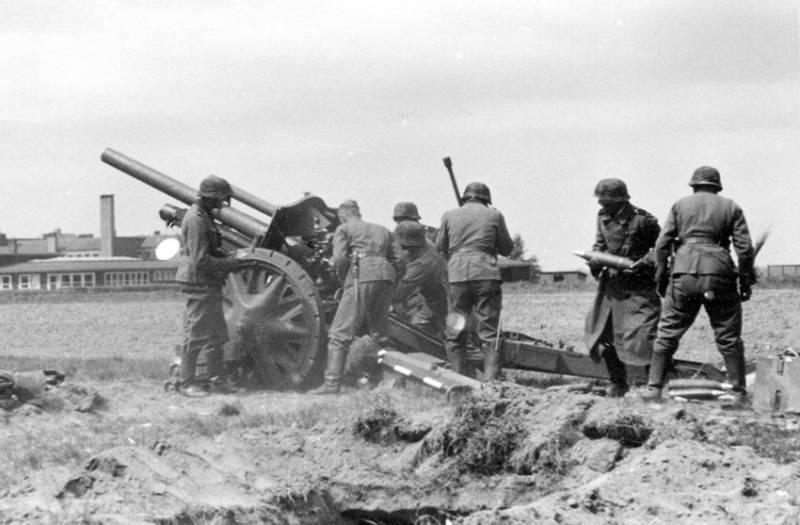
The horizontal firing sector was 56°, which made it possible to quickly transfer fire without turning the gun and increased the effectiveness of direct fire at fast-moving targets. The maximum vertical aiming angle is 42°. The wedge horizontal bolt provided a rate of fire of up to 8 rounds/min. Time to transfer to combat position is 2 minutes.
Compared to the 105-mm howitzer of the 1916 model, the new gun became significantly heavier. The mass of the artillery system in the combat position was 1 kg, in the stowed position - 985 kg. German designers were aware that to increase the mobility of an artillery battery, mechanical traction should be used. But in the 3s, Germany did not have the required number of tractors, and the first le.FH265 howitzers were produced in a version designed to be towed by six horses, and were equipped with wooden wheels with a metal rim, on top of which a rubber band was attached.
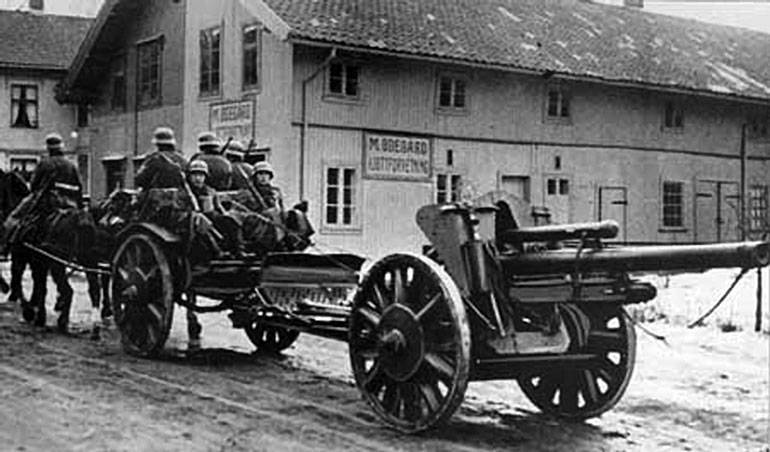
For mechanically driven batteries, guns with light alloy wheels with solid rubber tires were intended. Such howitzers could be towed at speeds of up to 40 km/h. The standard means of towing 105 mm howitzers in the Wehrmacht were the 3-ton Sd.Kfz.11 and 5-ton Sd.Kfz.6 half-track tractors.
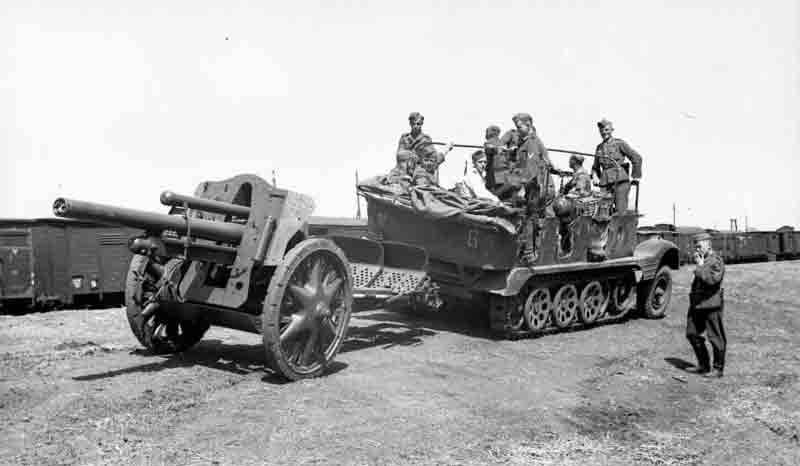
It is noteworthy that in two hours a mechanized howitzer battery could cover the distance that a horse-drawn battery covered in a whole day.
Since 1942, RSO (Raupenschlepper Ost) tracked tractors have been used to tow 105 mm howitzers.
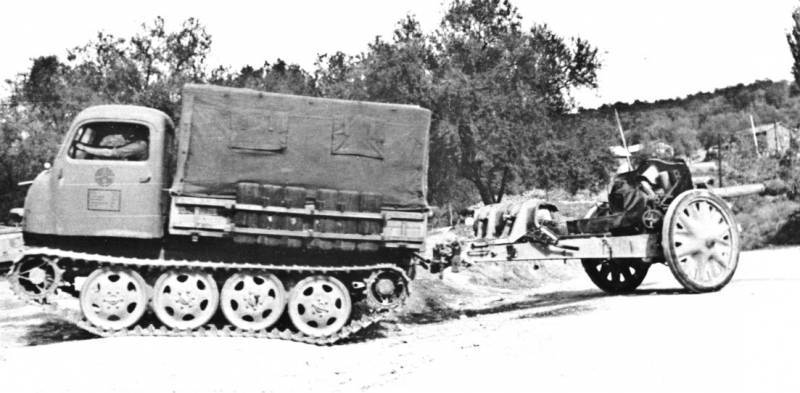
Compared to half-track tractors, it was a simpler and cheaper vehicle. But the maximum towing speed of howitzers was only 17 km/h (versus 40 km/h for the Sd.Kfz.11 and Sd.Kfz.6 half-track tractors).
The main ammunition in the ammunition load was considered to be a shot with a high-explosive fragmentation grenade 10,5 cm FH Gr. 38 weighing 14,81 kg, containing 1,38 kg of TNT or ammotol. When such a projectile exploded, lethal fragments scattered 10–15 meters forward, 5–6 meters back and sideways 30–40 meters. In the event of a direct hit, a 35-cm reinforced concrete wall, a 1,5-m-thick brick wall, or 30-mm armor could be broken through.
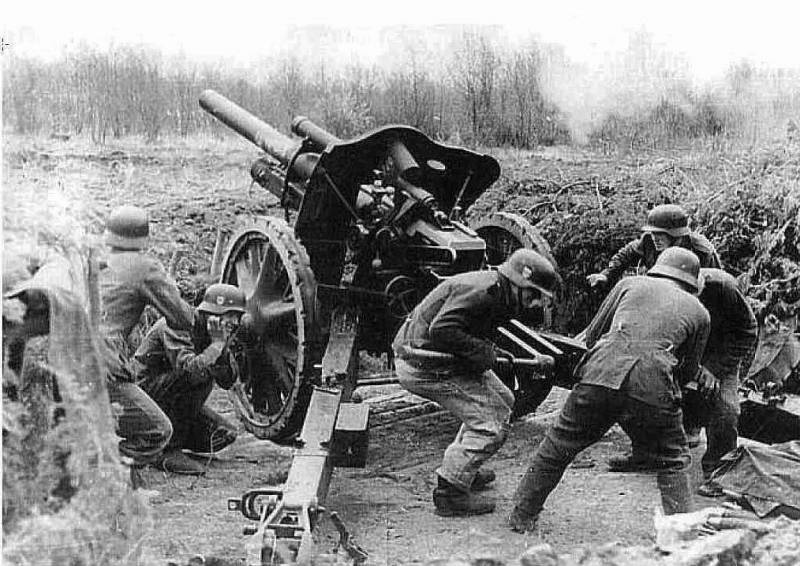
To combat tanks there were 10,5 cm Pzgr armor-piercing shells. and 10,5 cm Pzgr.rot. The first option, with a mass of 14,25 kg (explosive weight - 0,65 kg), left the barrel at a speed of 395 m/s and could hit targets at a range of up to 1 m. The 500 cm Pzgr.rot projectile with a ballistic tip weighed 10,5, 15,71 kg (explosive weight – 0,4 kg). With an initial speed of 390 m/s at a distance of 1 m, when hit at a right angle, it was capable of penetrating 500 mm thick armor.
The 10 cm Gr cumulative projectile had greater armor penetration. 39 rot H1, weighing 11,76 kg, containing a 1,975 kg charge of TNT alloy with hexogen. Regardless of the firing distance, when hit at a right angle, the cumulative jet penetrated 140 mm armor.
The 105-mm howitzer was also capable of firing 10,5 cm FHGr.Spr.Br incendiary fragmentation shells, 10,5 cm FHGr.Br incendiary shells, and 10,5 cm FHGr.Nb smoke shells. FES.
A brass or steel case (depending on the elevation angle and firing range) could accommodate six powder charges. At the first number of the propellant charge, the initial speed was 200 m/s (range – 3 m), at the sixth – 575 m/s (range – 470 m).
105 mm light field howitzer 10,5 cm le.FH18M
After reflecting on the experience of combat use of 105-mm howitzers 10,5 cm le.FH18, German generals expressed a desire to increase the firing range. The easiest way to achieve this was to increase the initial velocity of the projectile by increasing the volume of the propellant charge and the length of the barrel. A significantly longer barrel would have made the gun heavier and more expensive, and in the end it was decided to limit itself to increasing the volume of the powder charge, and to compensate for the increased recoil with a muzzle brake. After which the weight of the gun increased by only 55 kg, and the barrel became 467 mm longer.
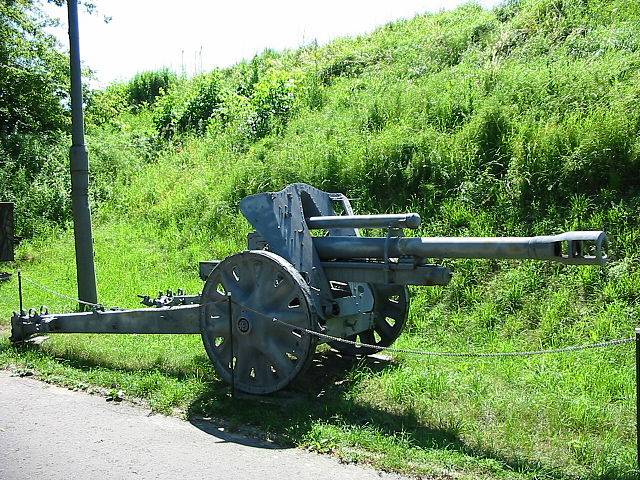
Field howitzer 10,5 cm le.FH18M on display at the museum
The 105 mm howitzer 10,5 cm le.FH18M with a two-chamber muzzle brake replaced the 10,5 cm le.FH18 in production in 1940.
To fire at maximum range, we developed a new high-explosive fragmentation projectile 10,5 cm F. H. Gr. F. When firing with charge No. 6, the initial speed was 540 m/s, and the firing range was 12 m. The remaining characteristics of the 325 cm le.FH10,5M howitzer remained at the level of 18 cm le.FH10,5.
During the repair of guns that received battle damage and required replacement of a worn barrel, early models received barrels with a muzzle brake. Due to the fact that the 10,5 cm le.FH18 and 10,5 cm le.FH18M howitzers were counted at one position, it is now impossible to find out exactly how many guns of a particular modification were produced. According to reference data, in the period from January 1939 to February 1945, the customer accepted 6 le.FH933 and le.FH18M units on a wheeled carriage.
105 mm light field howitzer 10,5 cm le.FH18 / 40
The modernized 10,5 cm le.FH18M guns were fully suitable for their purpose. But in Russian off-road conditions, the 3-ton Sd.Kfz.11 half-track tractors and even the 5-ton Sd.Kfz.6 had difficulty towing 105 mm howitzers.
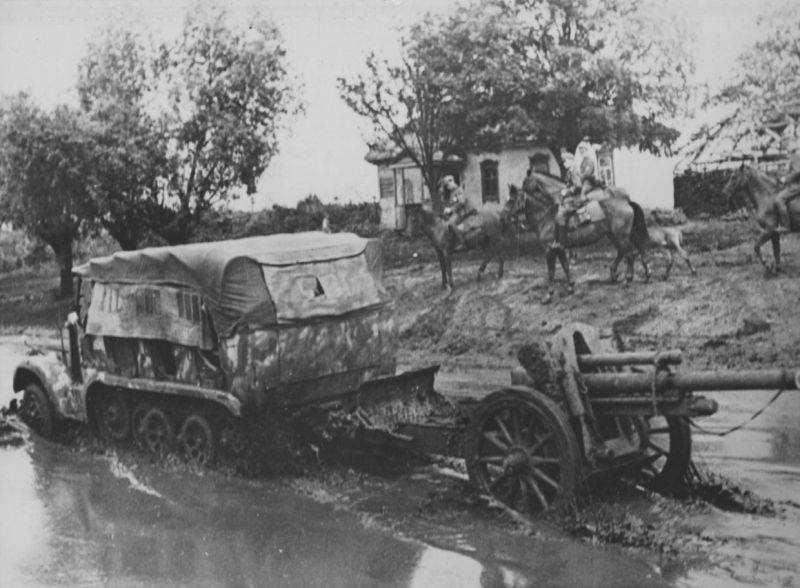
The situation with mobility was even worse in artillery units, which used horse-drawn teams to transport howitzers, and in the Wehrmacht there were approximately 70% of them in the first half of the war.
If the front line was stable, then the low speed of movement was not critical. But when guns needed to be immediately transferred to another site, this was often difficult to accomplish. On a bad road, the horses quickly got tired, and therefore the crews were forced to walk and even push howitzers. At the same time, the speed of towing by horse teams was 3–5 km/h.
They tried to solve the problem of mobility and security by creating self-propelled artillery units. So, using the chassis of the light tank Pz.Kpfw. II Ausf F produced the 105-mm Wespe self-propelled gun. However, relatively few such self-propelled guns were produced - 676 units, and they could not significantly displace the towed 105-mm howitzers.
During wartime, work was carried out in Germany to create a new 105 mm divisional gun, which, while maintaining the characteristics of the 10,5 cm le.FH18M, would be significantly lighter. However, due to organizational difficulties and in conditions of an acute shortage of production capacity, it was not possible to complete this work, and 105-mm le.FH18M howitzers were mass-produced until production stopped in March 1945.
In the middle of 1942, as a temporary measure, before the adoption of a new 105-mm howitzer, the barrel of the 10,5 cm le.FH18M was placed on the carriage of the 75-mm anti-tank gun 7,5 cm Pak 40. This modification was designated 10,5 cm le.FH18/40. The weight of the hybrid in the combat position was reduced to 1 kg; the weight in the stowed position was 830 kg.
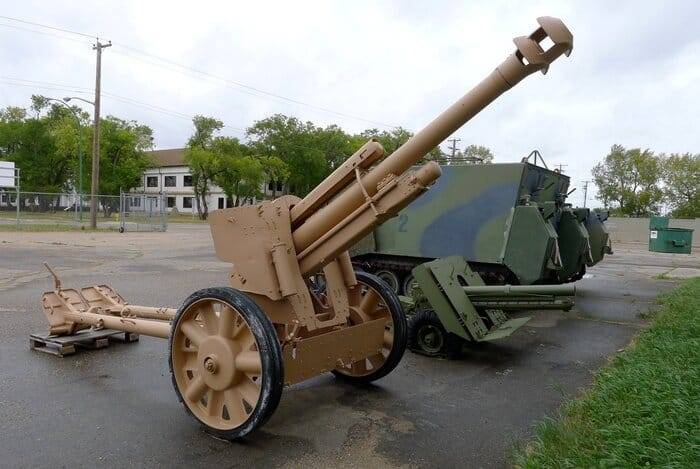
Light field howitzer 10,5 cm le.FH18/40 on display at the museum
The 10,5 cm le.FH18/40 howitzer has become significantly lighter compared to the 10,5 cm le.FH18M, which partly improves mobility. This was especially true for units where horse traction was used for towing.
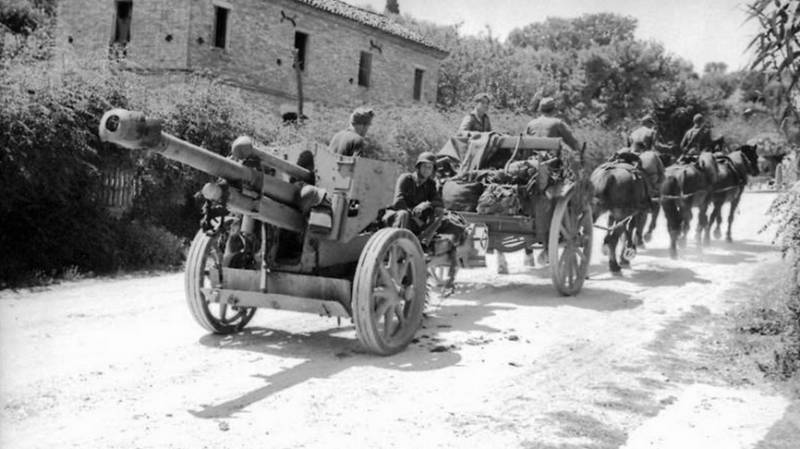
The process of introduction into mass production was delayed, and the customer received the first nine guns only in March 1943. But after four months, the Wehrmacht had 418 howitzers of this type. Until March 1945, it was possible to produce 10 le.FH245/18. At the same time, it is worth noting that the large-scale production of 40-mm hybrid howitzers had a negative impact on the pace of deliveries of 105 cm Pak anti-tank guns. 7,5, which were constantly missing.
105 mm howitzers in the armed forces of Nazi Germany
Soon after the launch of mass production of 10,5 cm le.FH18 howitzers, the German command decided to abandon guns in the divisional artillery. In the pre-war period, artillery regiments assigned to infantry divisions were armed only with howitzers - 105 mm light and 150 mm heavy. The main reason for this decision was the desire to ensure superiority in artillery over the armies of neighboring countries: in most of them, divisional artillery was represented by 75–76 mm cannons.
Until 1939, fire support for the actions of a German infantry division was to be provided by two artillery regiments: light (105 mm howitzers) and heavy (150 mm howitzers). After the transition to wartime conditions, the heavy regiments were removed from the divisions.
Subsequently, practically throughout the entire war, the organization of the infantry division's artillery remained unchanged: an artillery regiment consisting of three divisions, and in each of them - three four-gun batteries of 105-mm howitzers.
Initially, an artillery regiment of motorized (panzergrenadier) divisions corresponded in structure to an infantry division regiment - three three-battery divisions (36 howitzers). Subsequently, the composition of the regiment was reduced to two divisions (24 guns).
The tank division initially had two divisions of 105 mm howitzers, and its artillery regiment also included a heavy division (150 mm howitzers and 105 mm guns). Since 1942, one of the light howitzer divisions has been replaced by a self-propelled artillery division with Wespe or Hummel self-propelled guns.
In 1944, in order to improve controllability, the division of light howitzers in the tank divisions underwent a reorganization: instead of three four-gun batteries, two six-gun batteries were introduced into its composition.
By the beginning of World War II, the armed forces of Nazi Germany had 4 light 845 mm howitzers. These were mainly le.FH105 guns, with the exception of some old le.FH18 systems, as well as former Austrian and Czech howitzers. By April 16, 1, the fleet of light howitzers increased to 1940 units, and by June 5, 381 - to 1 units.
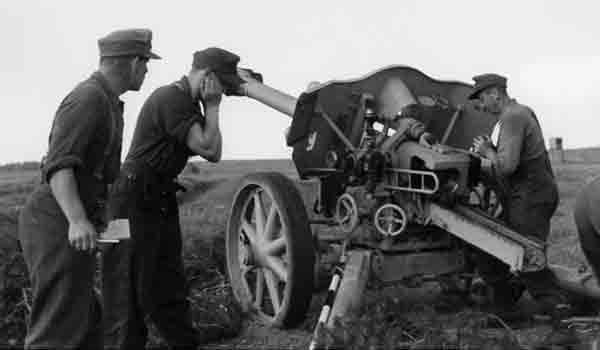
Despite heavy losses on the Eastern Front, 105 mm light howitzers remained very numerous throughout the war. For example, on May 1, 1944, the Wehrmacht had 7 howitzers, and on December 996 - 1 (however, in both cases, not only towed, but 7-mm guns intended for the Wespe and StuH 372 self-propelled guns were taken into account).
In total, the industry received 19 le.FH104 howitzers of all modifications. And they remained the basis of the Wehrmacht divisional artillery until the end of hostilities.
In general, German 105-mm howitzers were very successful. They successfully coped with the destruction of manpower located openly or behind light cover, with the destruction of light field fortifications, and the suppression of firing points and artillery. In a number of cases, light howitzers placed under direct fire successfully repelled attacks by medium and heavy tanks.
Comparison of German 105-mm howitzers with foreign analogues
When assessing the German le.FH18 howitzers, it would be appropriate to compare them with the American 105 mm M2A1 Howitzer (M101) howitzer and the Soviet 122 mm M-30 howitzer, which are also one of the best artillery systems used in World War II.
The American howitzer had a maximum firing range of 11 m and weighed 270 kg in combat position. A well-trained crew could fire 2 rounds/min. Towing speed – up to 260 km/h.
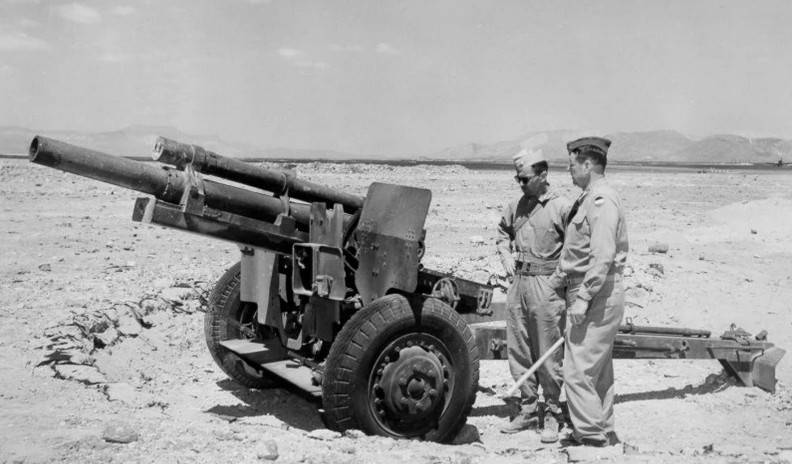
American soldiers next to the 105 mm M101 howitzer
The main ammunition of the 105-mm American howitzer was the M1 high-explosive fragmentation projectile weighing 14,97 kg. This ammunition, loaded with 2,18 kg of TNT, had a high-explosive effect significantly superior to the German 105-mm high-explosive fragmentation grenade 10,5 cm FH Gr. 38, containing 1,38 kg of explosives. But in terms of fragmentation effect, the German shell was better. At the same time, the German howitzer could fire more shells in a short period of time, which was important when organizing a sudden fire raid or when shooting at moving targets.
The Soviet divisional 122-mm howitzer of the 1938 model (M-30) was slightly superior to the le.FH18 of the first modification in terms of maximum firing range (11 m versus 800 m). However, in later versions, the firing range of German 10-mm howitzers was increased to 675 m.
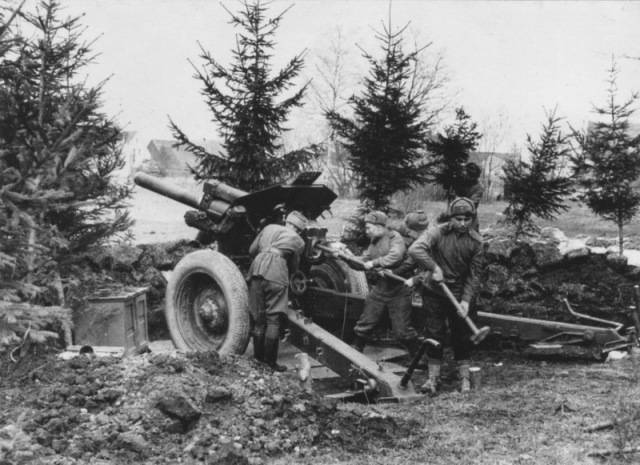
A Soviet artillery crew is busy equipping a trench and preparing a 122-mm M-30 howitzer for firing.
The greater elevation angle (+63,5°) of the barrel of the Soviet M-30 made it possible to achieve a greater steepness of the projectile trajectory compared to the German le.F.H18, and therefore better efficiency when firing at enemy personnel hidden in trenches and dugouts.
In terms of power, the 122-mm projectile weighing 21,76 kg clearly outperformed the 105-mm projectile. But the price for this was a 400 kg greater mass of the M-30 in combat position and, accordingly, worse mobility. The practical rate of fire of the German le.FH18 was 1,5–2 rounds/min higher.
Use of 105 mm captured German howitzers
Episodic cases of short-term use of captured 105-mm howitzers in the Red Army were noted in the summer and autumn of 1941. At the end of 1941 - beginning of 1942, due to the massive death of horses caused by cold weather and lack of fodder, during the subsequent rapid counter-offensive of the Red Army, the Germans abandoned several dozen light 105-mm field howitzers. A significant part of the captured le.FH18 guns were in disrepair, but some howitzers turned out to be suitable for further use. If ammunition was available, they were used to fire at visually observable targets.
In 1942, German light 105-mm howitzers were tested at the Gorokhovets Artillery Research Site (ANIOP) and at the GAU Research Anti-Aircraft Artillery Test Site (NIZAP). Judging by the available photographs, these were guns of the first modification without a muzzle brake.
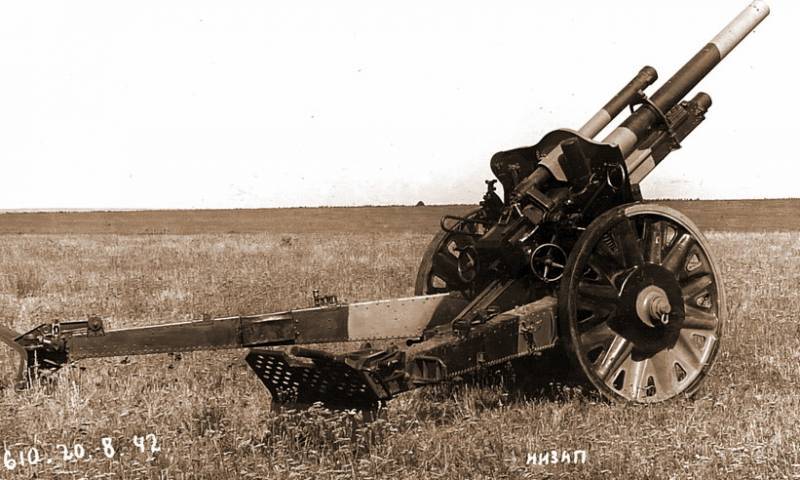
105-mm howitzer le.FH18 at the NIZAP training ground
Soviet experts concluded that the combat and service characteristics of the gun fully correspond to modern requirements. Structurally, the 105-mm howitzer is simple and technologically advanced. In its production, scarce alloys and metals are not used, and the widespread use of stamping made it possible to reduce the cost. A number of technical solutions are recognized as worthy of close study. The maneuverability of the gun was rated as satisfactory.
After the defeat of the German 6th Army, surrounded at Stalingrad, among the captured trophies were several hundred 105-mm howitzers, in varying degrees of preservation, and a large amount of artillery ammunition. Subsequently, the bulk of the faulty and damaged captured le.FH18 guns were repaired at Soviet enterprises, after which they were sent to front-line artillery depots. Firing tables, lists of ammunition nomenclature were translated into Russian, and operating instructions were published.
Serviceable and restored 105-mm captured howitzers were supplied to artillery regiments of rifle divisions, where they, together with Soviet 122-mm howitzers and 76-mm guns, were used as part of mixed artillery divisions.
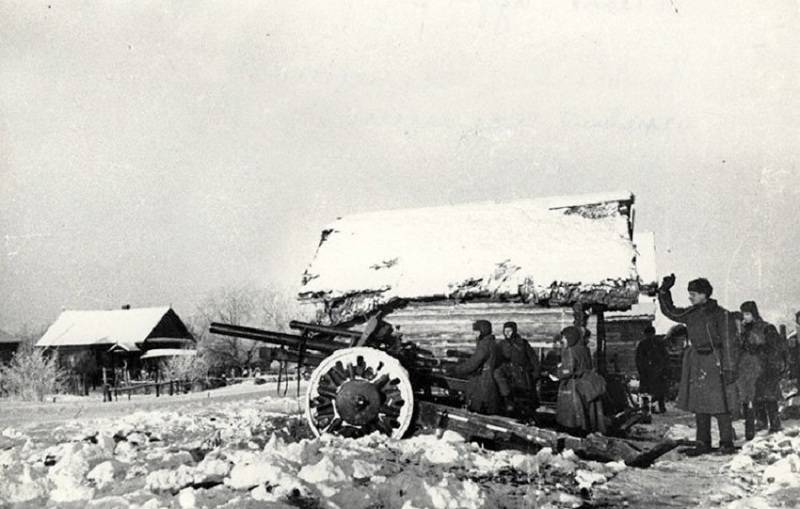
Short-term courses were organized to train rank-and-file crews and gun commanders in the front-line zone. Battery commanders underwent more in-depth training in the rear.
In addition to the training of personnel, the possibility of using guns captured from the enemy was determined by the availability of ammunition, which the Soviet industry did not produce. In connection with this, the captured teams were given the task of organizing the collection of shells and shots for 105-mm howitzers. In the absence of appropriate serviceable captured guns in a given section of the front, the ammunition was transferred to warehouses, from where units with captured materiel were already centrally supplied.
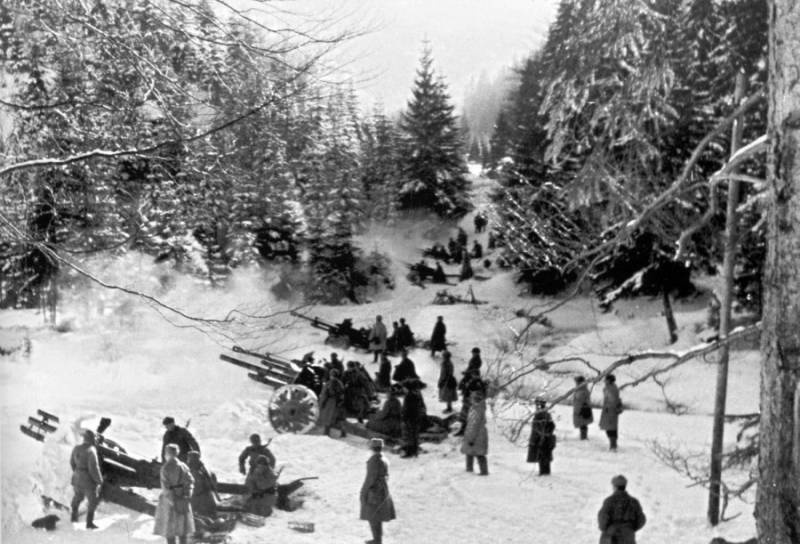
After the Red Army seized the strategic initiative and moved on to large-scale offensive operations, the number of German-made 105-mm howitzers in the artillery units of the Red Army increased sharply.
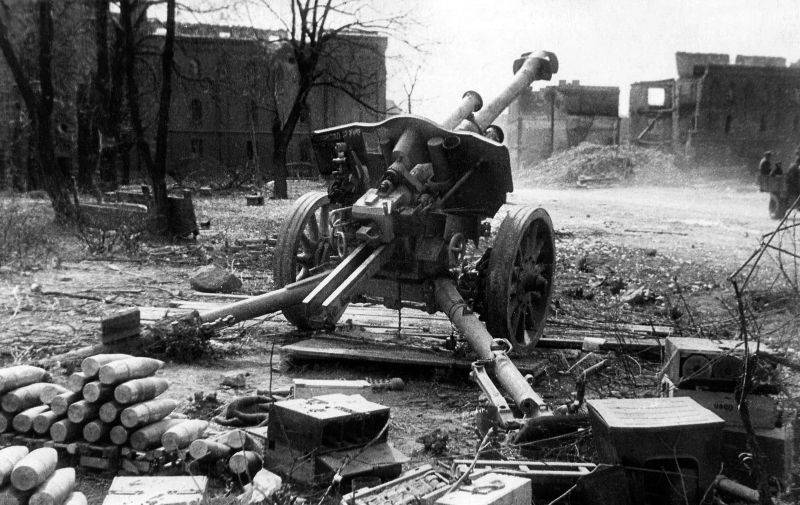
German 105 mm howitzer abandoned at a position in Konigsberg
In order to increase the strike capabilities of some rifle divisions conducting offensive combat operations, additional batteries of 105-mm howitzers were introduced into the artillery regiments assigned to them.
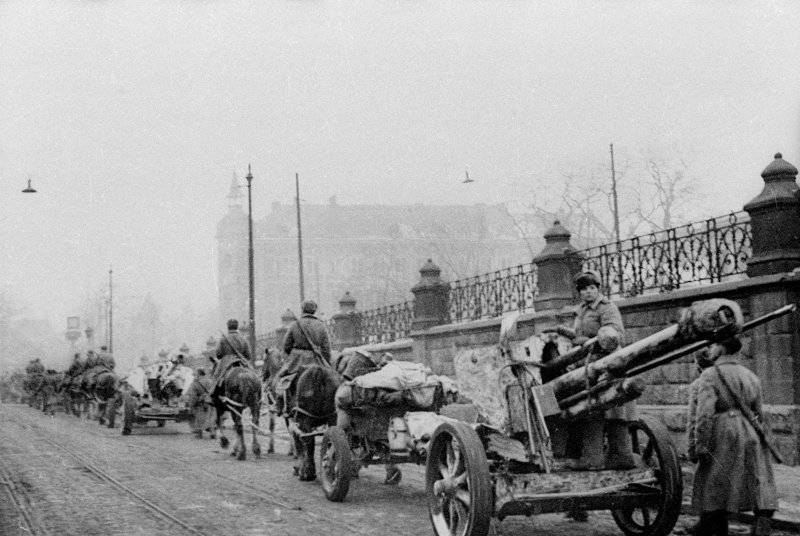
Captured 105-mm howitzers were often deployed as close as possible to the enemy’s front line and were used to destroy pockets of defense, long-term firing points, and to make passages in anti-tank barriers. If there was a sufficient amount of ammunition, it was prescribed to conduct harassing fire on areas deep in the enemy’s defenses.
By the end of World War II, the artillery units of the Red Army and at collection points for captured weapons had up to 1 le.FH000 howitzers, in varying states of preservation, and several hundred thousand rounds for them.
In the post-war period, captured 105-mm howitzers were subjected to troubleshooting. Guns in satisfactory technical condition and sufficient service life were sent for storage, where they remained until the early 1960s.
At the end of the 1930s, 105 mm le.FH18 howitzers underwent a baptism of fire in Spain. The Spanish Army operated these guns until the second half of the 1950s. Even before the attack on the Soviet Union, Hungary and Bulgaria received such howitzers. Slovakia in 1944 had 53 howitzers. Finland acquired 1944 le.FH53M howitzers and 18 le.FH8/18 howitzers in 40, and they remained in service until the end of the 1970s. Neutral Sweden bought 142 le.FH18 guns, which served until 1982.
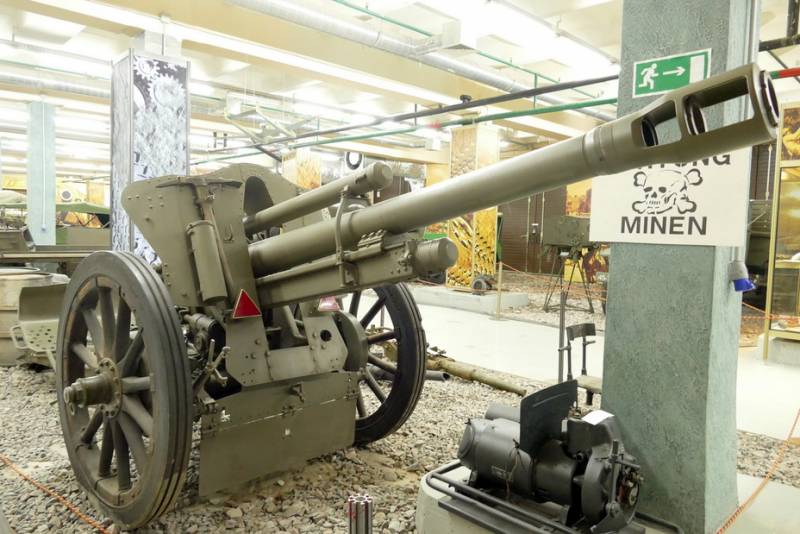
105-mm howitzer le.FH18М in the Finnish museum
After the end of World War II, captured German 105-mm howitzers became widespread. In addition to the above countries, they were adopted in Albania, Poland, Portugal, Czechoslovakia, Yugoslavia and France.
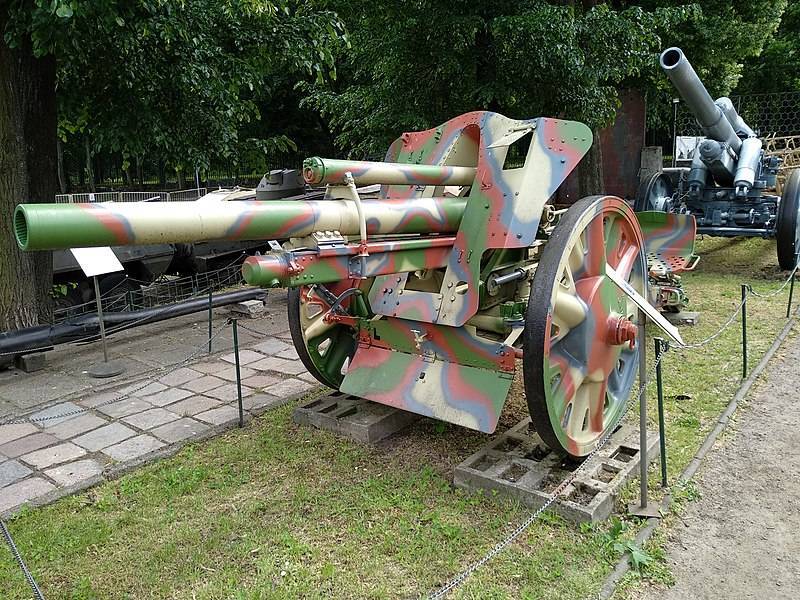
105-mm le.FH18 howitzer in the Museum of the Polish Army. Warsaw
Captured 105-mm howitzers were used in Yugoslavia for several decades. The first battery of le.FH18M howitzers was recaptured by soldiers of the 1st Proletarian Division from the Germans at the beginning of 1943. In the second half of 1944, a noticeable number of le.FH18s were captured by the Yugoslav People's Army in Dalmatia. Soon after the end of the war, another 84 howitzers were received from the Allies.
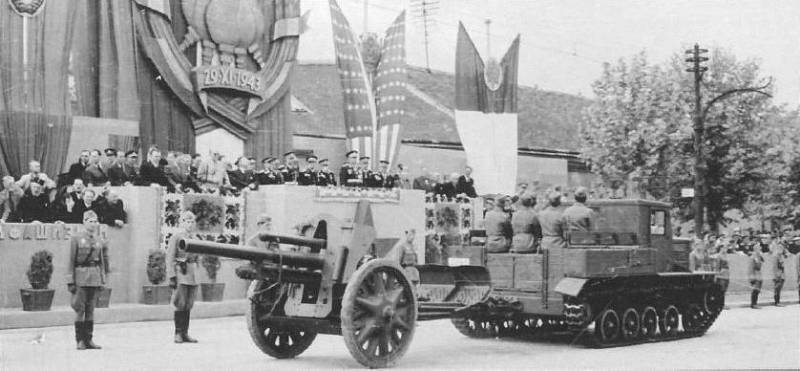
Howitzer le.FH18, towed by a Soviet Ya-12 tractor, at the parade in honor of Victory Day. Belgrade, 1947
Initially, the JNA command hoped to re-equip the divisional artillery with Soviet guns, and at the end of the 1940s, Yugoslavia transferred 55 German howitzers to Albania. But after the break with the USSR, the process of removing German equipment from service stalled. In 1951, Yugoslavia received 100 le.FH18/40 howitzers and 70 shells from France.
In 1951, Yugoslavia created its own 105 mm howitzer, adapting it to fire 105 mm American-style shells.
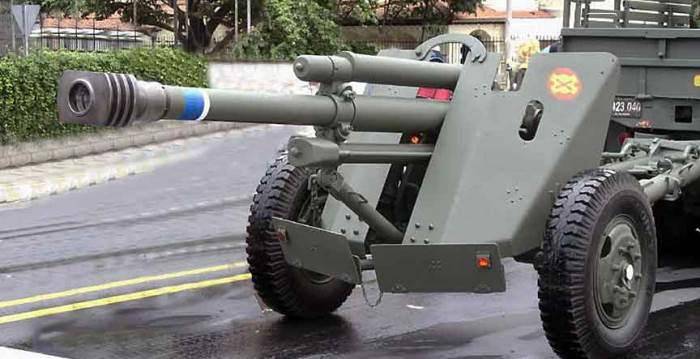
A special feature of the M-56 is that, in case of emergency, you can open fire before the carriage frames are moved apart. True, in this case the angle of horizontal and vertical guidance is significantly reduced. Production of this gun, known as the M-56, began in 1956. M-56 howitzers were supplied to Guatemala, Indonesia, Iraq, Mexico, Myanmar and El Salvador.
M-56 howitzers were actively used by warring parties during the civil war of 1992–1996. In a number of cases they played a key role during the fighting. For example, during the shelling of the Croatian city of Dubrovnik in 1991 and during the siege of Sarajevo from 1992 to 1996.
In 1960, the JNA had more than 260 German 105 mm howitzers in service. Due to a shortage of shells in the early 1960s, they were modernized by placing the M-56 barrel on the le.FH18 carriage. The modernized Yugoslav howitzers received the designation M18/61.
During the civil war that began after the collapse of Yugoslavia, M18/61 guns were used by all warring parties. As part of a regional arms reduction agreement, the Serbian army retired 61 M18/61 howitzers in 1996. There are four such guns left in the army of Bosnia and Herzegovina, which were only decommissioned in 2007.
Portugal bought a large batch of 105-mm howitzers 10,5 cm le.FH18M from France in the early 1950s.
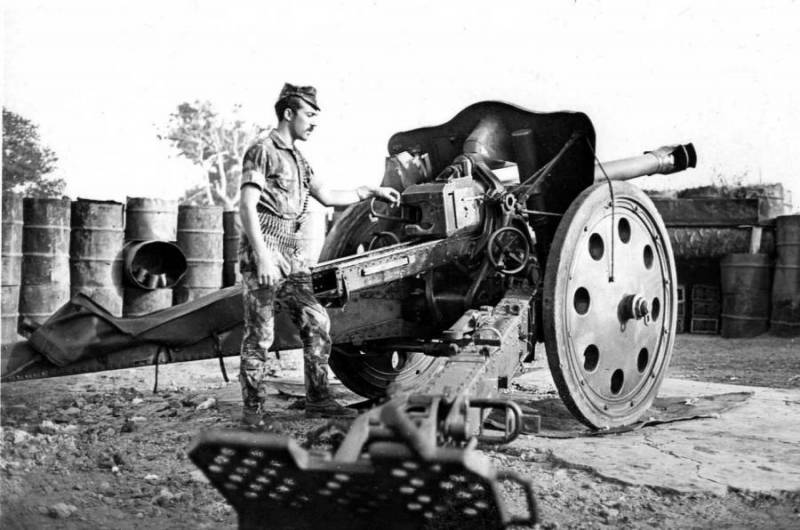
During the 1960s and 1970s, the Portuguese Army used 105mm howitzers against rebels during the colonial wars in Angola, Guinea-Bissau and Mozambique. The last 10,5 cm le.FH18M in Portugal were written off in the early 1990s.
After the end of the war, the armed forces of Czechoslovakia had more than 300 le.FH18 guns of various modifications. Initially, captured howitzers were used in their original form. But in the early 1950s, a significant part of the guns was modernized. At the same time, the le.FH18/40 artillery unit was placed on the carriage of the Soviet 122-mm M-30 howitzer. This gun was designated 105 mm H vz.18/49.
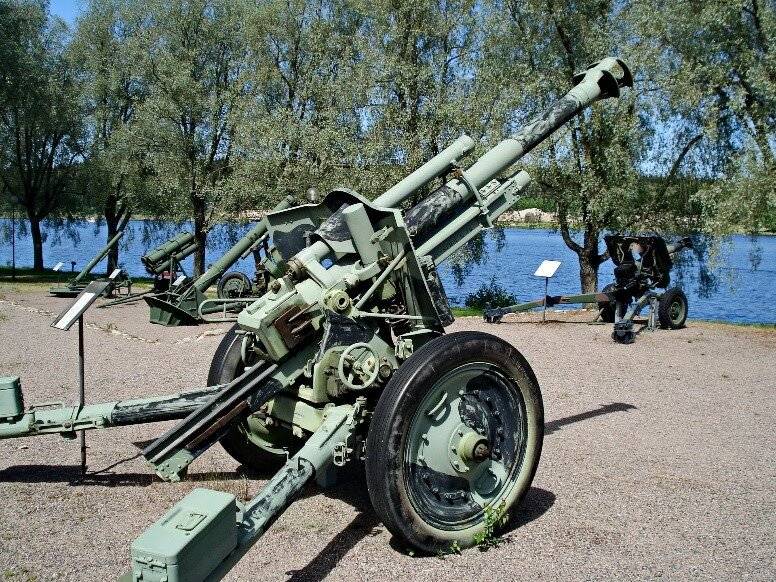
Czechoslovak howitzer 105 mm H vz.18/49
After Czechoslovakia began to switch to Soviet calibers in the late 1950s, 105 mm H vz.18/49 howitzers were offered to foreign buyers at a reasonable price. The main operator of these guns was the Syrian army, and they were actively used in the Arab-Israeli wars of 1967 and 1973.
Active service of 105-mm Czech-German hybrids in the Syrian army continued until the mid-1970s. After which the surviving howitzers were sent to storage bases and used for training purposes.
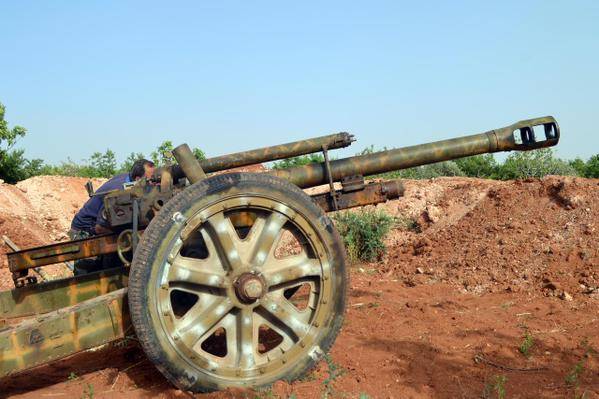
In 2012, Syrian militants managed to capture artillery storage bases, where (among other types) there were 105 mm H vz.18/49 howitzers. Several of these guns were used in combat.
Продолжение следует ...
Information